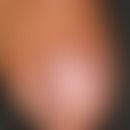DefinitionThis section has been translated automatically.
Often severe, non-suppressible permanent itching in chronic renal failure (stage of compensated retention) due to retention of urinary substances. Dialysis patients also very often suffer from pronounced itching. Itching in patients requiring dialysis occurs as a permanent itching (due to retention of urinary substances, probably a sign of uremic neuropathy) or as intermittent dialysis itching (probably sensitization to substances of the extracorporeal circulation). A connection with secondary hyperparathyroidism in uremia is discussed (e.g. renal insufficiency, skin changes).
EtiopathogenesisThis section has been translated automatically.
S.u. Pruritus nephrogener
TherapyThis section has been translated automatically.
The first choice therapy is UV radiation (UVB or high-dose UVA1).
Capsaicin (0.01-0.5% in a cream base or as a shaking mixture) is helpful at least temporarily in some cases. Cave! Therapy costs! S.a. renal insufficiency, skin changes.
Thalidomide 100 mg/day showed an alleviating effect in controlled studies ( off-label use).
Other options that have proven successful in studies: activated carbon 6 g/day, gabapentin 3 times/week 300 mg after dialysis.
The integument of the renal insufficiency patient is dry and scaly. Consistent external care measures such as fatty lotions 2 times/day (e.g. Excipial Lipolotio, Lipoderm Lotion) are indicated. External lotions with urea additives are generally well tolerated (e.g. 2-5% urea cream, nubral cream or excipial hydro- or lipolotio, R102, R104 ). Extremely sparing use of cleaning agents such as syndets or soaps. Instead, use hydrophilic body oils as washing substitutes (e.g. hydrophilic body oil or ready-to-use preparations that are generally used as oil baths, such as oil bath Cordes, Linola Fett N oil bath, Balneum Hermal oil bath).
Recently, success has been described with ondansetron (e.g. Zofran 4-8 mg/day). Successes with low-dose erythropoietin have been described (18 U/kg bw/day, 3 times/week i.v.).
Notice! Oral antihistamines are ineffective.
Try non-steroidal anti-inflammatory drugs such as Metamizole 1000-2000 mg/day (e.g. Novalgin 2-4 Tbl.) or opioid antagonists e.g. Naltrexone (50 mg/day). The study results for naltrexone are contradictory. Considerable side effects such as nausea, vomiting, sleep disturbances, dizziness are to be noted.
Incoming links (4)
Pruritus cum materia; Thalidomide; Urea cream hydrophilic 5 or 10% (nrf 11.71.); Urea emulsion, hydrophilic 5 or 10% (nrf 11.72.);Outgoing links (13)
Erythropoietin; Lotion; Metamizole; Non steroidal anti-inflammatory drugs; Off-label use; Ondansetron; Pruritus; Pruritus nephrogenic; Thalidomide; Urea cream hydrophilic 5 or 10% (nrf 11.71.); ... Show allDisclaimer
Please ask your physician for a reliable diagnosis. This website is only meant as a reference.



